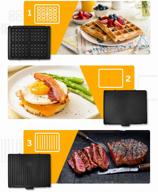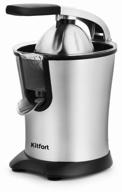
Review on 🌡️ uxcell Mini LCD Refrigerator Freezer Fridge Digital Thermometer Black - Accurate Temperature Monitoring for Optimal Food Storage by Laurie Garcia

Not bad for the cheap price.
This unit is truly designed for through the panel installation. It snaps into a rectangular hole in a panel or box, etc. When used in this manner, it provides a fairly "clean" installation. However, you'll need to get into the box or behind the fairing to swap out the batteries if necessary. It's not really meant to be used "freestanding" but if you don't care how it looks and don't mind it's not really what you imagine the finished product to be, it gets the job done . I haven't used this thing long enough to know how long the battery lasts. And that brings up another point. Since this device requires two small button cells to operate, it will likely cost the same as the thermometer originally cost just to replace them if you buy the "good ones" at retail. However, there is nothing to complain about because this gadget is very inexpensive. I tested mine on ice point water and found it reading 1.3 degrees Celsius too high (reading 1.3 when it should be reading 0.0). I also tested it at around 50 degrees Celsius and found it to be about 1 degree below normal at that point. That's not terrible accuracy for a cheap thermometer, but could be better with a little adjustment. , the board has solder pads that allow you to switch it to Fahrenheit. The other panel looks like it could be used for refresh rate acceleration. However, battery life will likely be reduced if you choose a faster refresh rate. There are also two surface mount resistors on the board and it may be possible to calibrate the device by adjusting the values of these resistors. Maybe I'll try that sometime and report if it works. It would be nice to be able to adjust offset and gain to improve accuracy but for the price I paid this unit tells me if my freezer is working within reasonable limits. Knowing that the ice point is off 1.3 degrees (mine) and that the tilt is wrong, I know what to expect. Measuring the temperature of a fridge or freezer is difficult anyway, as they cycle on and off and the actual temperature in a typical home freezer varies by up to 10 degrees Celsius anyway. So the reading depends on what part of the loop you're capturing when checking the reading. But the cable to the sensor is thin enough that you can thread it through the door seal and take measurements without opening the door to the sensor. Fridge or freezer and that's exactly what I wanted. The sensor reacts fairly quickly. For scientific purposes, refrigerator thermometers typically use a small vial of liquid to "quench" the thermometer's reaction rate. That way you have some hope of opening the fridge door and getting the reading before the temperature gets too high. Even with a thermometer where you can take a reading without opening the door, the reading is very dependent on when in the cycle you are taking the reading. To that end, you might want to do something to slow down the response rate so you see more than average every time you check. Slowing down a sensor's response speed is a little harder than people think. Most people assume that just placing the sensor in a large container of water or something similar will slow down the response. But interestingly, the rate of an object's thermal response depends on the ratio of surface area to heat capacity, not just size. For example, a gallon pitcher of water has exactly the same response rate as a liter pitcher of the same shape. Because the ratio of surface area to mass is the same for both containers. What you really want to do to slow down the temperature sensor is increase the thermal capacity AND isolate it to some degree to achieve the desired thermal response time. You also need to consider sensor self-heating rather than just isolating a tiny sensor. This can result in artificially high readings due to the power dissipation of the sensor itself. In this case the system will consume very little power and the sensor will most likely only read intermittently and briefly, so the power dissipation will be very small. However, it is important to note that you will need some surface area on the final sensor assembly to ensure self-heating does not introduce errors. These sensors appear to be sealed and may be waterproof. So for a fridge you can just put the probe in a small, semi-insulated container of water to slow it down. However, the container must be airtight, or at least sealed sufficiently, as evaporation of the water will cause the water to cool below ambient temperature. In order to obtain accurate readings, the water must not evaporate. I prefer to use an insulated aluminum body to get the required thermal time constant as this is easier to manage in the long run. But then again, this thermometer isn't very accurate anyway, so I doubt most people would be willing to go to that length of trouble. Just remember that fridges and freezers cycle on and off and the temperature inside fluctuates. So unless you take action to account for this, what you see at a glance may not reflect the actual average temperature.
- Large selection
- Annoys
New products
Comments (0)
Top products in 🧂 Kitchen Utensils & Gadgets
Another interesting products
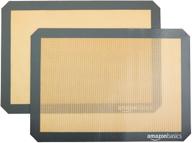
AmazonBasics Silicone Baking Mat Sheet

48 Review

PME Scriber Needle Modelling Tool, For Cake Decorating, 5.7-Inch

38 Review
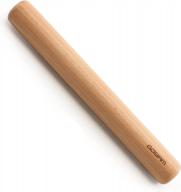
GOBAM Wood Rolling Pin: The Perfect Dough Roller For Baking Cookies, Pie, Pizza & More - 13 X 1.38 Inches

35 Review
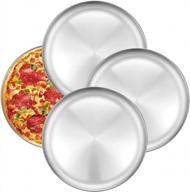
4 Pack 12 Inch Stainless Steel Round Pizza Baking Pan Tray Crisper Sheet Oven Cooking Healthy For Pizzas - Deedro

47 Review


